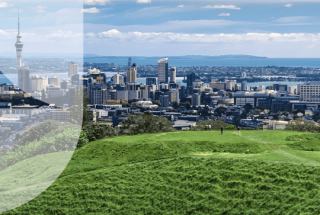Just another year in local government

Just another year in local government
Monday 20 November, 2023
![]()
Download a PDF of this article here
As might have been expected in the year of a general election, there has been a pretty much deafening silence in response to the once much anticipated final report on the Review into the Future for Local Government / He piki tūranga, he piki kotutuku (see our June article here).
It was not so much that no one was interested in the Panel conclusions and recommendations, but rather that Government and opposition members alike were too spooked and/or distracted by the coming election to want to commit to a view on an overhaul of the system. Added to that was the fact that major environmental and water reforms were underway and that the sponsor of the review, the Hon Nanaia Mahuta, lost her job as Minister of Local Government in a Cabinet reshuffle in February. Her replacement, Minister Kieran McAnulty, simply kicked for touch until after the election, and other political commentators were similarly reserved. Now he too is out of that job, and the report remains mired in this post-election pre-Christmas stew of end-of-year tasks.
What has been happening?
That is a shame. The year has been marked by escalating issues that heavily impact local government governance and services, but which are largely out of its control. These include but are not limited to:
- Climate change
- Engagement with Māori
- Funding new and improved infrastructure
- Housing provision and affordability
- Environment regulation
Climate change
In 2023 New Zealanders felt the impact of weather as never before. At the start of the year an entirely unprepared Auckland was hit first by Cyclone Hale in January, later in the month by the Auckland Anniversary Weekend floods, and in February along with the rest of the North Island by Cyclone Gabrielle. Lives were lost. Homes and businesses were damaged or destroyed. Infrastructure was crippled or worse. And regions like Gisborne and Hawkes Bay were devastated almost beyond repair. For those of us living in the northern parts of NZ it feels as if it has rained more or less continually all year. In fact, in July NIWA reported that 21 locations in 7 different North Island regions had their highest Jan-June rainfalls since records began.
Yes, it was the La Nina cycle of the south osculation. But combined with the increasing number of extreme weather events now being seen around the world it is starting to look a lot like climate change. And we were not ready. Local and central Government are still trying to work out who pays for what; the insurance industry is refusing to bear the brunt and demanding change alongside higher premiums; industries that play an aggravating role such as forestry are trying to avoid liability; and water adjacent householders are demanding seawalls, groynes, stop banks, along with other short-term protection measures that generally just shift the problem along to their neighbours.
Engagement with Māori
In other areas local government also continues to struggle. The quantity and quality of engagement with Māori and recognition of Te Tiriti / Treaty of Waitangi principles has improved in leaps and bounds over recent years. But the determined shove given by former Minister Mahuta may have backfired, being a bit much for some and not enough for others. The easier implementation of Māori wards and
constituencies, the growing use of Te Reo in public documents and events, and the growth of co-governance as a part of environmental and water reform, have all contributed to a fairly vigorous backlash – not just from the far right, but also from middle-New Zealanders who are not quite sure whether they are witnessing a renaissance or a reverse takeover. Local government must be wondering what is now expected of it in this regard, particularly in view of the pre-election statements of coalition partner the Act party on electoral reforms designed to benefit Māori.
Infrastructure
Funding new and improved infrastructure, and indeed understanding infrastructure needs, is even more of an issue in the aftermath of the extreme weather events this year. Roads, houses, businesses, bridges, schools, public buildings, power and communications lines and structures, water ways, reticulation, and treatment plants – all and more have been damaged and need repair or replacement. The Government is contributing but the burden largely falls on an already under-funded local government sector that was already struggling to maintain, replace, and build new infrastructure. If housing was a crisis point before it has not been improved by the loss of accommodation caused by this year’s severe weather events. Further those events have called into question the wisdom of exploiting land for new development where there may be flooding issues, and the forced intensification of existing urban areas. We can expect to see more red flags on the suitability of certain areas for development and redevelopment, and yet more push-back from developers unwilling to be the conduit for the collection of infrastructure costs to enable new development.
Environment and Water
New Acts to replace the Resource Management Act 1991 and to create a legislative framework for water services (water supply, wastewater, and storm water) have been passed since last year, with the most recent in the final weeks of the outgoing Government. It is not clear whether this raft of legislation, much of which has yet to commence, will survive the incoming Government. Certainly, the pre-election rhetoric would suggest that whatever coalition position is reached, the new water services and environmental Acts will not survive without extensive modification. But don’t expect a wholesale reversion to what went before – the provision for reform has gone too far in respect of both areas, and neither the National nor Act parties were supporters of the results achieved under the legacy legislation.
Ahead of us
Who knows which, if any of the recommendations of the Future for Local Government Panel will be implemented, but we suspect tinkering rather than major change is on the cards.
So what are councils to do? Well, they cannot expect to remain untouched by change. Shared services, voluntary arrangements and amalgamations are all on the cards. Governance issues such as community and Māori engagement will continue to be a priority with different approaches in different areas. We recommend that you talk to your neighbouring councils, seek shared solutions to common issues, and work hard on engagement with local MP’s, Ministers of the Crown, and government agencies. Above all – keep informed and responsive to change.
Nothing new, just more of it.







